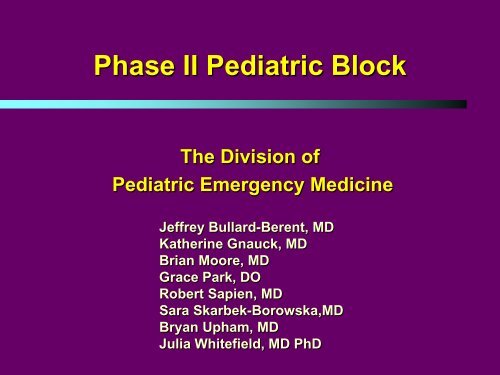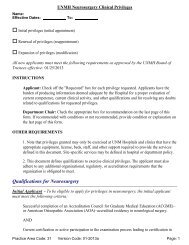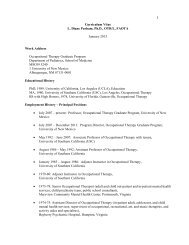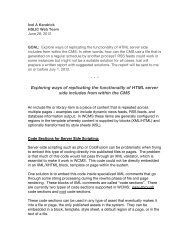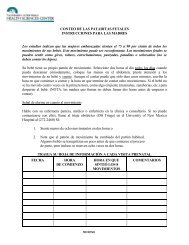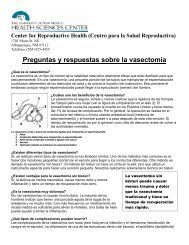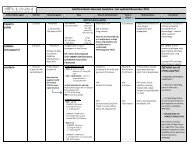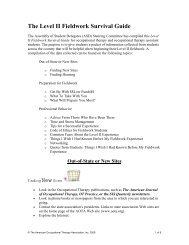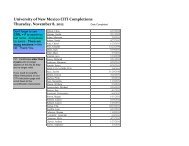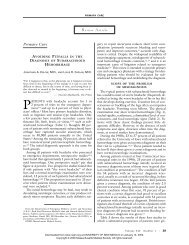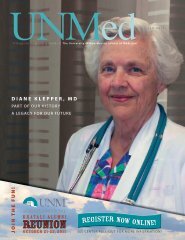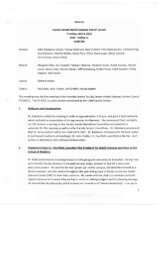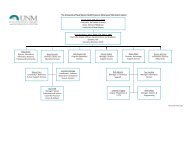Phase II Pediatric Block - HSC
Phase II Pediatric Block - HSC
Phase II Pediatric Block - HSC
- No tags were found...
You also want an ePaper? Increase the reach of your titles
YUMPU automatically turns print PDFs into web optimized ePapers that Google loves.
<strong>Phase</strong> <strong>II</strong> <strong>Pediatric</strong> <strong>Block</strong><br />
The Division of<br />
<strong>Pediatric</strong> Emergency Medicine<br />
Jeffrey Bullard-Berent, MD<br />
Katherine Gnauck, MD<br />
Brian Moore, MD<br />
Grace Park, DO<br />
Robert Sapien, MD<br />
Sara Skarbek-Borowska,MD<br />
Bryan Upham, MD<br />
Julia Whitefield, MD PhD
PEM Critical Knowledge<br />
(in < 1 hour)<br />
Introduce the <strong>Pediatric</strong> Assessment Triangle<br />
• Distinguishing PAT and ABCDE<br />
Understand the Anatomic and Physiologic<br />
differences between adults and children in<br />
regard to:<br />
• Respiratory Distress<br />
• Shock<br />
• Trauma
<strong>Pediatric</strong> Assessment Triangle<br />
Appearance<br />
Breathing<br />
Circulation
Appearance<br />
Tone<br />
Interactiveness<br />
Consolability<br />
Look/Gaze<br />
Speech/Cry
Work of Breathing<br />
Abnormal airway<br />
sounds<br />
Abnormal positioning<br />
Retractions<br />
Nasal flaring<br />
Head bobbing
Circulation to Skin<br />
Pallor<br />
Mottling<br />
Cyanosis
General Approach<br />
<strong>Pediatric</strong> Assessment Triangle (PAT)<br />
Hands-on assessment of ABCDEs<br />
• <strong>Pediatric</strong> differences
Airway<br />
Airway opening maneuvers:<br />
Head tilt-chin lift, jaw thrust<br />
Suction:<br />
Often dramatic improvement in infants<br />
Age-specific obstructed airway support:<br />
• 1 year: Abdominal thrust<br />
Advanced airway techniques
Breathing:<br />
Respiratory Rate Varies with Age<br />
Age<br />
Respiratory Rate<br />
Infant 30 to 60<br />
Toddler 24 to 40<br />
Preschooler 22 to 34<br />
School-aged child 18 to 30<br />
Adolescent 12 to 16<br />
Slow or fast respirations are worrisome.
Breathing: Auscultation<br />
Midaxillary line, above sternal notch<br />
• Stridor:<br />
• Wheezing:<br />
• Grunting:<br />
• Crackles:<br />
• Decreased /<br />
absent breath<br />
sounds:<br />
Upper airway obstruction<br />
Lower airway obstruction<br />
Poor oxygenation; pneumonia,<br />
drowning, pulmonary contusion<br />
Fluid, mucus, blood in airway<br />
Obstruction
Circulation:<br />
Heart Rate varies by Age<br />
Age<br />
Normal Heart Rate<br />
Infant 100 to 160<br />
Toddler 90 to 150<br />
Preschooler 80 to 140<br />
School-aged child 70 to 120<br />
Adolescent 60 to 100
Circulation<br />
Pulse: Central, peripheral pulse quality<br />
Skin temp: “Reverse thermometer” sign<br />
Capillary refill: ≤ 2 sec, warm finger, 5 sec<br />
B/P: Minimum = 70 + (2 X age in years)
Disability (and Dextrose)<br />
AVPU scale:<br />
• Alert<br />
• Verbal: Responds to verbal commands<br />
• Painful: Responds to painful stimulus<br />
• Unresponsive<br />
(<strong>Pediatric</strong>) Glasgow Coma Scale<br />
Check Dextrose (glucose) if impaired
Exposure / Environment<br />
Full Exposure Necessary<br />
• Evaluate physiologic function<br />
• Identify anatomic abnormalities<br />
Maintain warm ambient environment<br />
Minimize heat loss<br />
Monitor temperature<br />
Warm IV fluids
Reassess<br />
General impression (PAT)<br />
ABCDE<br />
Continually reassess ABCs for response to<br />
therapy
The Bottom Line<br />
Begin with PAT, then ABCDEs.<br />
Form a general impression to guide priorities.<br />
Treat respiratory distress, failure, and shock as they<br />
are recognized.<br />
Focused history and detailed PE.<br />
Reassessment throughout ED stay.
Airway / Breathing
Objectives<br />
Compare anatomic, physiologic differences<br />
b/w adult & pediatric airway<br />
Distinguish respiratory distress from failure<br />
Describe clinical features of upper and lower<br />
airway obstruction and diseases of the<br />
lung
Respiratory arrest vs cardiac<br />
arrest intact survival rates in<br />
children<br />
90<br />
80<br />
70<br />
60<br />
50<br />
40<br />
30<br />
20<br />
10<br />
0<br />
Respiratory<br />
Cardiac
Why do children have more<br />
respiratory difficulties?<br />
Anatomic<br />
Physiologic
Anatomy<br />
Large occiput – need shoulder roll<br />
Large tongue – obstruction<br />
Cephalad larynx – difficult to visualize<br />
Soft epiglottis – use Miller blades<br />
Smallest diameter below cords<br />
Small airways – high resistance
Physiology: <strong>Pediatric</strong> vs Adult<br />
Higher Basic Metabolic Rate = Shorter time<br />
to Desaturation<br />
• (6-8 mL/kg vs 3-4)<br />
Smaller airways =<br />
Higher Airway Resistance (1/R 4 )<br />
Prolonged respiratory distress -> failure
Physiology: Time to Desaturation
Signs of Respiratory<br />
Distress and Failure<br />
Respiratory Distress<br />
• Tachypnea<br />
• Stridor<br />
• Retractions<br />
• Head bobbing<br />
• Nasal Flaring<br />
Respiratory Failure<br />
• Altered mental<br />
status<br />
• Poor resp effort<br />
• Bradypnea<br />
• Bradycardia<br />
• Apnea<br />
Resp failure = inadequate oxygenation or ventilation
Mild Respiratory Distress:<br />
Accessory Muscle Usage
Severe Respiratory Distress:<br />
Accessory Muscle Usage
Airway Obstruction:<br />
Upper Vs. Lower<br />
Upper<br />
Lower<br />
Stridor<br />
Sturtor<br />
Cough<br />
Retractions<br />
Apnea<br />
Resp effort<br />
w/o air<br />
entry<br />
Wheeze<br />
↓ breath<br />
sounds
Airway Obstruction Causes:<br />
Upper Vs. Lower<br />
Upper<br />
• Croup<br />
• Foreign Bodies<br />
• Epiglotitis<br />
(rare)<br />
Lower<br />
• Bronchiolitis<br />
• Asthma<br />
• Foreign Bodies
Upper Airway Obstruction:<br />
Croup
Upper Airway Obstruction:<br />
Treatment<br />
Reposition Airway<br />
Suction (infants, in particular)<br />
Partial obstruction – position of comfort<br />
Complete obstruction<br />
• Back blows/ chest thrusts < 1 yo<br />
• Abdominal thrusts > 1year<br />
N-P airway – sturtor; O-P airway (no gag)<br />
Advanced techniques
Lower Airway Obstruction:<br />
Treatment<br />
Oxygen / Supportive (bronchiolitis)<br />
Beta 2 agonist (albuterol in asthma)<br />
Bronchoscopy (foreign body)
Case 1 – Airway/Breathing<br />
cc: “Funny breathing”<br />
HPI: 14 month male with acute resp dist. No prior<br />
symptoms. Mom in other room, noted “funny<br />
breathing” while he was playing on the floor.<br />
ROS: No fevers, Otherwise well<br />
PE: AF, VSWNL except RR 50<br />
Gen: Awake, alert, stridor at rest, mod resp dist<br />
Pulm: Retractions x3, transmitted airway sounds<br />
CV: RRR, no m/r/g, nl pulses, cap refill
Case 1 – Airway/Breathing<br />
Would you:<br />
a) Use a BVM, prepare to Intubate<br />
b) Give abdominal thrusts<br />
c) Give back blows/chest thrusts<br />
d) Place in position of comfort<br />
e) Start CPR<br />
f) Discharge home
Case 1 – Airway/Breathing<br />
Would you:<br />
a) Use a BVM, prepare to Intubate<br />
b) Give abdominal thrusts<br />
c) Give back blows/chest thrusts<br />
d) Place in position of comfort<br />
e) Start CPR<br />
f) Discharge home
Case 2 – Airway/Breathing<br />
cc: “Choked”<br />
HPI: 9 month male with difficulty breathing. Mom<br />
was feeding him grapes and peanuts. Had a<br />
choking episode, was making “funny<br />
sounds”, then during your exam stopped<br />
breathing and turned blue.<br />
ROS: No fevers, Otherwise well<br />
PE: AF, resp effort at 60, HR 190, SpO2 65%<br />
Gen: Limp, cyanotic.<br />
Pulm: Supraclavicular retractions, no air entry<br />
CV: Tachycardic, no m/r/g, 2+ pulses, ↓ CR
Case 2 – Airway/Breathing<br />
Would you:<br />
a) Use a BVM, prepare to Intubate<br />
b) Give abdominal thrusts<br />
c) Give back blows/chest thrusts<br />
d) Place in position of comfort<br />
e) Perform cricothyroidotomy<br />
f) Discharge home
Case 2 – Airway/Breathing<br />
Would you:<br />
a) Use a BVM, prepare to Intubate<br />
b) Give abdominal thrusts<br />
c) Give back blows/chest thrusts<br />
d) Place in position of comfort<br />
e) Perform cricothyroidotomy<br />
f) Discharge home
Respiratory Rate Varies by Age<br />
Age<br />
RR<br />
Newborn 35-50<br />
Older infants/ toddlers 30-40<br />
Elementary<br />
school age 20-30<br />
Older child/<br />
adolescent 12-20
Case 3 – Airway/Breathing<br />
cc:<br />
“Trouble breathing”<br />
HPI: 9 month male with difficulty breathing.<br />
Cough, difficulty breathing x 4 days. Not<br />
taking fluids well, now “lethargic”.<br />
ROS: Fever to 102 F, decreased wet diapers.<br />
PE: AF, RR 12, HR 190, SpO2 78%<br />
Gen: Limp, shallow resp effort.<br />
Pulm: Coarse bs, poor air entry<br />
CV: Tachycardic, no m/r/g, central pulses only, ↓<br />
CR 5-6 seconds
Case 3 – Airway/Breathing<br />
Would you:<br />
a) Use a BVM, prepare to Intubate<br />
b) Give abdominal thrusts<br />
c) Give back blows/chest thrusts<br />
d) Place in position of comfort<br />
e) Perform cricothyroidotomy<br />
f) Discharge home
Case 3 – Airway/Breathing<br />
Would you:<br />
a) Use a BVM, prepare to Intubate<br />
b) Give abdominal thrusts<br />
c) Give back blows/chest thrusts<br />
d) Place in position of comfort<br />
e) Perform cricothyroidotomy<br />
f) Discharge home
Circulation
Heart Rate Also Varies with Age<br />
Age<br />
Normal Heart Rate<br />
Infant 100 to 160<br />
Toddler 90 to 150<br />
Preschooler 80 to 140<br />
School-aged child 70 to 120<br />
Adolescent 60 to 100
Cardiac Output<br />
CO = HR x Stroke Volume<br />
Infants/children ↑ CO by ↑HR >> SV
Shock: Definition and Types<br />
Inadequate tissue perfusion (delivery of<br />
oxygen and nutrients) to meet the<br />
metabolic demands of the body.<br />
• Hypovolemic<br />
• Cardiogenic<br />
• Distributive<br />
• Septic
Shock: Definitions<br />
Compensated:<br />
• Vital organs perfused by compensatory<br />
mechanisms<br />
• B/P is normal<br />
Decompensated:<br />
• Compensatory mechanisms overwhelmed,<br />
inadequate<br />
• Hypotension, high mortality risk<br />
Aggressive treatment of early shock:<br />
• Halts progression to decompensated shock
Shock Clinical Features:<br />
Your First Clues<br />
Abnormal mental status<br />
Apnea<br />
Tachycardia (hypotension NOT necessary)<br />
Grunting, respiratory distress<br />
Pale, cool skin; delayed capillary refill<br />
• Warm shock CR will appear normal to brisk
Clinical Features of Specific<br />
Shock Types<br />
Neurologic deficits (spinal cord injury)<br />
Urticaria, allergen trigger, wheezing<br />
(anaphylactic)<br />
Petechiae, erythroderma (septic)
Hypovolemic Shock<br />
Fluid loss:<br />
• Diarrhea, vomiting, anorexia, diuresis<br />
• Hemorrhage<br />
Resuscitation:<br />
• Fluid replacement<br />
• NS or LR 20 mL/kg bolus, reassess, repeat as<br />
needed<br />
• Blood transfusion for excessive hemorrhage
Septic Shock<br />
Has elements of distributive shock and<br />
cardiogenic shock:<br />
• Inappropriate vasodilation with a<br />
maldistribution of blood flow<br />
• Myocardial depression<br />
Resuscitation:<br />
• Fluid boluses: 20cc/kg x3 in the first 15<br />
minutes<br />
• Dopamine, Epinephrine or Norepinephrine<br />
• Antibiotics
Trauma
Trauma: Epidemiology<br />
Trauma is leading cause of death and disability in<br />
children worldwide.<br />
Most common injuries:<br />
• Infants: Physical abuse<br />
• Preschoolers: Falls<br />
• School aged: Motor vehicle collision – pedestrian or<br />
bicyclist<br />
Differences in anatomy, physiology, mechanism<br />
drive differences in injury pattern, response.
How Trauma Differs<br />
in <strong>Pediatric</strong>s (1 of 3)<br />
Anatomy/Physiology<br />
Proportionately larger<br />
head<br />
Injury Response<br />
Higher frequency of head<br />
trauma, higher c-spine<br />
trauma<br />
Large occiput and tongue<br />
More airway obstruction
How Trauma Differs<br />
in <strong>Pediatric</strong>s (2 of 3)<br />
Anatomy/Physiology<br />
Thinner chest wall,<br />
more flexible ribs<br />
Horizontal ribs, weaker<br />
intercostals, more<br />
mobile mediastinum<br />
Abdominal organs more<br />
anterior and less<br />
subcutaneous fat<br />
Injury Response<br />
Higher frequency of<br />
pulmonary injury<br />
Tension pneumothorax<br />
poorly tolerated<br />
Higher risk of intraabdominal<br />
injury and<br />
bleeding
How Trauma Differs<br />
in <strong>Pediatric</strong>s (3 of 3)<br />
Anatomy/Physiology<br />
Softer bones, thicker<br />
periosteum<br />
Active, unfused bony<br />
growth plates<br />
Compensatory<br />
vasoconstriction<br />
Larger body surface<br />
area/mass ratio<br />
Injury Response<br />
Higher frequency of<br />
incomplete fractures<br />
Disrupted growth after<br />
growth plate fractures<br />
Normal blood pressure<br />
with early shock<br />
Greater heat loss from<br />
exposed body surfaces<br />
(head)
Trauma Assessment<br />
Primary survey<br />
• <strong>Pediatric</strong> Assessment Triangle (PAT)<br />
• ABCDEs (F- family)<br />
• Treat ABCDE in the order you find them<br />
Secondary survey<br />
• Head to toe exam<br />
Reassess
Summary<br />
PAT = General impression (Appearance, B, C)<br />
ABCDE = Airway, Breathing, Circulation, Disability /<br />
Dextrose, Extremities/Environment, F=Family<br />
Reassess response to treatment<br />
Respiratory Distress – Anat / Phys / Environmental<br />
Shock – Compensated /Decompensated, Tachycardia<br />
Trauma – Anatomic differences, logical approach
Thank you!


